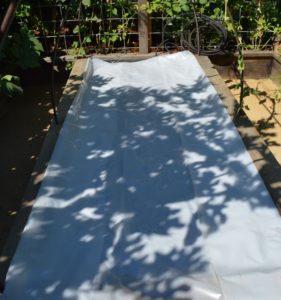Managing Weeds
Garden Tips | SHARE
Weed management is one of the challenges that every gardener has to deal with at times. Weeds can be introduced into your garden by many methods—on the wind, in the soil of transplants, by birds and other wildlife, to name a few.
The best time to deal with weeds is before you’ve planted anything else. When you have open ground to weed, you can choose from a wider range of strategies without worrying that you’ll damage other plants. To manage weeds before planting, follow these steps:
- Identify the Type of Weeds. Knowing what weeds you’re dealing with and whether they are annual or perennial weeds will help you figure out the best way to eradicate them. Use the University of California Statewide Integrated Pest Management Program’s key to identifying weeds to help you name the weed.
- Prepare the Site. This can mean hand-weeding or spraying the area with a post-emergent herbicide for quick results, or, if time allows, solarizing the soil or smothering the weeds with cardboard and mulch.
- Don’t Introduce New Weeds. Take care that you don’t bring weed seeds into the area you’ve prepared. Make sure any compost you add has been thoroughly composted at a high enough temperature to kill any weed seeds and that any plants you transplant don’t carry any weed seeds or seedlings.
- Encourage Plants to Establish. The sooner other plants are settled into the area, the sooner the ground will fill up, leaving less opportunity for weeds to establish. By providing your plants with adequate water and sunlight and applying mulch, you’ll give your plants the best chance to outgrow and hold their own against the weeds.
There is no single way to manage weeds and the best approach depends on the type of weed and where the weed is in your garden. Following are some weed management methods and tools to consider:
- Hand-Weeding: While painstaking in large, open areas, hand weeding may often be the best choice for clearing weeds growing among other plants. It’s important to pull the entire plant, including roots, in order to be effective.
- Mowing: This is the quick-and-dirty method to control but not eradicate weeds in open spaces. It’s most effective if you mow before the weeds have matured enough to set seed.
- String Trimmers: This is another method of controlling weeds without eradicating them. It’s often used on weeds that pop up in small crevices in driveways, patios and walkways.
- Mulch: A 3- to 4-inch layer of mulch is generally considered to be a very effective weed suppressant. Mulches can be organic (for example, wood chips, compost, straw) or inorganic (for example, gravel or decorative stone). Mulch can also be used on top of one or more layers of cardboard to smother stubborn weeds.

- Steam or Hot Water: Using a steam machine to apply steam or simply pouring hot water directly on weeds is a fairly effective killing method, although some weeds may require repeated treatments. This also works best on weeds that grow in cracks and it has the added benefit of damaging weeds seeds as well as the weeds themselves.
- Soil Solarization: Large weedy areas can be solarized by covering with plastic sheeting for a period of several weeks of hot weather to heat the soil up to 140°F to kill existing weeds and weed seeds. The downside of solarization is that it also kills beneficial insects and microorganisms living in the soil and it takes time for the soil to re-establish a healthy balance.
- Pre-emergent Herbicides: These herbicides work by inhibiting the germination of seeds, so while they don’t kill existing weeds, they prevent them from reproducing by seed and spreading. A commonly used organic pre-emergent herbicide is corn gluten meal.
- Post-emergent Herbicides: These herbicides kill existing weeds by attacking their means of photosynthesizing or processing nutrients. Round-Up is a commonly used post-emergent herbicide, but there are very effective organic alternatives that use orange oil, cloves, vinegar or other natural ingredients.One strategy that is best avoided is laying landscape fabric (also called weed cloth or geotextiles) as a weed suppressant. Many landscape cloths do not allow water to permeate as claimed and weed seeds can become caught in the fabric and sprout and grow there, making the cloth not only ineffective but difficult to maintain.For more information, refer to the University of California’s Statewide Integrated Pest Management Program’s web page on weed management in landscapes.